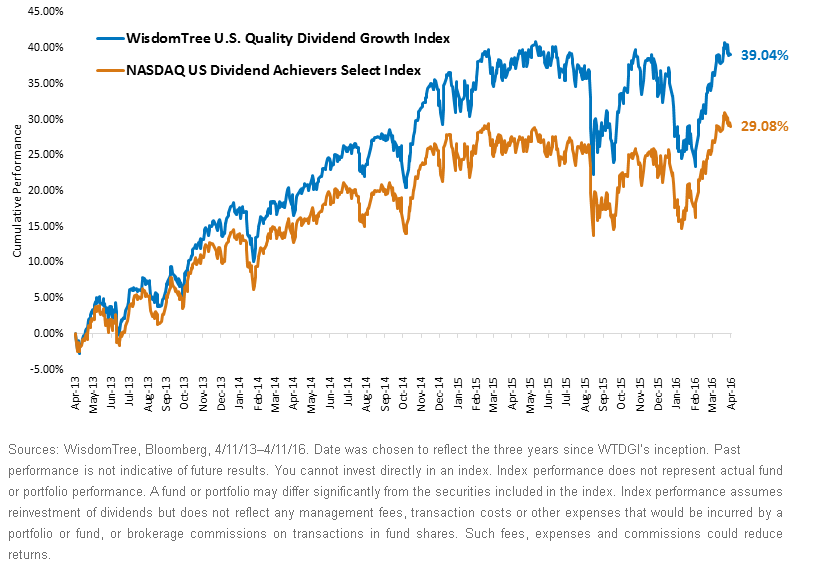More than three years ago, WisdomTree realized that indexes focused on historical
dividend growth and exchange-traded funds designed to track these backward-looking dividend indexes were extremely popular. While this seems like a smart idea, it keeps many investors from capitalizing on shifting trends in the dividend landscape and positioning for the future, specifically when it comes to newer payers and firms recovering from recent dividend contractions. Take Apple, for example.
1 Apple is currently the largest dividend payer in the United States but only started paying
dividends again in 2012
2. So if an index is using backward-looking screens that go back 10 to 20 years, as some do, it won’t include Apple for some time to come.
Always looking to innovate, WisdomTree created a forward-looking dividend growth Index that seeks to capture dividend growth trends that often are not captured by backward-looking indexes. The
WisdomTree U.S. Quality Dividend Growth Index (WTDGI) looks at
fundamental metrics that could indicate future dividend growth potential. Two variables govern stock selection:
•
Quality: Defined as companies with high
return on equity (ROE) and high
return on assets (ROA)—both key profitability metrics tied to dividend growth potential
•
Growth: Defined as companies with high expected
earnings growth, as future dividends must be funded from the cash flow a company generates
It is important to note that WisdomTree’s Dividend Indexes do not require historical dividend growth to be eligible for inclusion. We believe companies with a long history of dividend growth may not be the key drivers of tomorrow’s dividend growth and that it’s necessary to be more dynamic in the selection criteria to capture the current shifting trend in the U.S. dividend market.
To quantify the cost of looking backward for dividend growth over the past three years, the chart below shows the performance of WTDGI against its benchmark, the
NASDAQ US Dividend Achievers Select Index, whose methodology includes a 10-year dividend growth look-back screen.
Backward-Looking vs. Forward-Looking Strategies

•
Information Technology Added to Outperformance: WTDGI’s forward-looking methodology and quality bias have resulted in the Index being over-weight the Information Technology sector compared to indexes reliant on backward-looking dividend growth trends. This over-weight has added to its relative performance since inception, which makes sense to us, because the sector is also a dividend growth leader. To look at Apple again: after reinstating dividend payments back in 2012, the company has grown its dividend by 50% on a cumulative basis, or over 11% on an average annual basis.
3 Yet a 10-year backward-looking dividend growth methodology would exclude Apple until at least 2022.
Preparing for the Future
We believe that backward-looking strategies can keep the companies growing their dividends the fastest out of a portfolio. While no approach can predict which firms will increase future dividends, we believe that being broad, flexible and forward-looking will enable WTDGI to more quickly respond to—and better capitalize on—the changing U.S. dividend landscape. In turn, we believe this methodology will track the performance of the companies growing their dividends the fastest today—and tomorrow. Another important metric we feel can be
an indication for longer-run real returns is considering dividends and share
buybacks together, and WTDGI is one of our most attractive Indexes on that measure.
1As of 4/11/16, Apple was a 3.3% weight in the
WisdomTree U.S. Quality Dividend Growth Index.
2Source: WisdomTree, Bloomberg, As of 5/2/16.
3Sources: WisdomTree, Bloomberg; refers to dividend growth from dividend ex-date over the period of 8/9/12 to 05/05/16.
Important Risks Related to this Article
Dividends are not guaranteed, and a company currently paying dividends may cease paying dividends at any time.


 • Information Technology Added to Outperformance: WTDGI’s forward-looking methodology and quality bias have resulted in the Index being over-weight the Information Technology sector compared to indexes reliant on backward-looking dividend growth trends. This over-weight has added to its relative performance since inception, which makes sense to us, because the sector is also a dividend growth leader. To look at Apple again: after reinstating dividend payments back in 2012, the company has grown its dividend by 50% on a cumulative basis, or over 11% on an average annual basis.3 Yet a 10-year backward-looking dividend growth methodology would exclude Apple until at least 2022.
Preparing for the Future
We believe that backward-looking strategies can keep the companies growing their dividends the fastest out of a portfolio. While no approach can predict which firms will increase future dividends, we believe that being broad, flexible and forward-looking will enable WTDGI to more quickly respond to—and better capitalize on—the changing U.S. dividend landscape. In turn, we believe this methodology will track the performance of the companies growing their dividends the fastest today—and tomorrow. Another important metric we feel can be an indication for longer-run real returns is considering dividends and share buybacks together, and WTDGI is one of our most attractive Indexes on that measure.
1As of 4/11/16, Apple was a 3.3% weight in the WisdomTree U.S. Quality Dividend Growth Index.
2Source: WisdomTree, Bloomberg, As of 5/2/16.
3Sources: WisdomTree, Bloomberg; refers to dividend growth from dividend ex-date over the period of 8/9/12 to 05/05/16.
• Information Technology Added to Outperformance: WTDGI’s forward-looking methodology and quality bias have resulted in the Index being over-weight the Information Technology sector compared to indexes reliant on backward-looking dividend growth trends. This over-weight has added to its relative performance since inception, which makes sense to us, because the sector is also a dividend growth leader. To look at Apple again: after reinstating dividend payments back in 2012, the company has grown its dividend by 50% on a cumulative basis, or over 11% on an average annual basis.3 Yet a 10-year backward-looking dividend growth methodology would exclude Apple until at least 2022.
Preparing for the Future
We believe that backward-looking strategies can keep the companies growing their dividends the fastest out of a portfolio. While no approach can predict which firms will increase future dividends, we believe that being broad, flexible and forward-looking will enable WTDGI to more quickly respond to—and better capitalize on—the changing U.S. dividend landscape. In turn, we believe this methodology will track the performance of the companies growing their dividends the fastest today—and tomorrow. Another important metric we feel can be an indication for longer-run real returns is considering dividends and share buybacks together, and WTDGI is one of our most attractive Indexes on that measure.
1As of 4/11/16, Apple was a 3.3% weight in the WisdomTree U.S. Quality Dividend Growth Index.
2Source: WisdomTree, Bloomberg, As of 5/2/16.
3Sources: WisdomTree, Bloomberg; refers to dividend growth from dividend ex-date over the period of 8/9/12 to 05/05/16.

